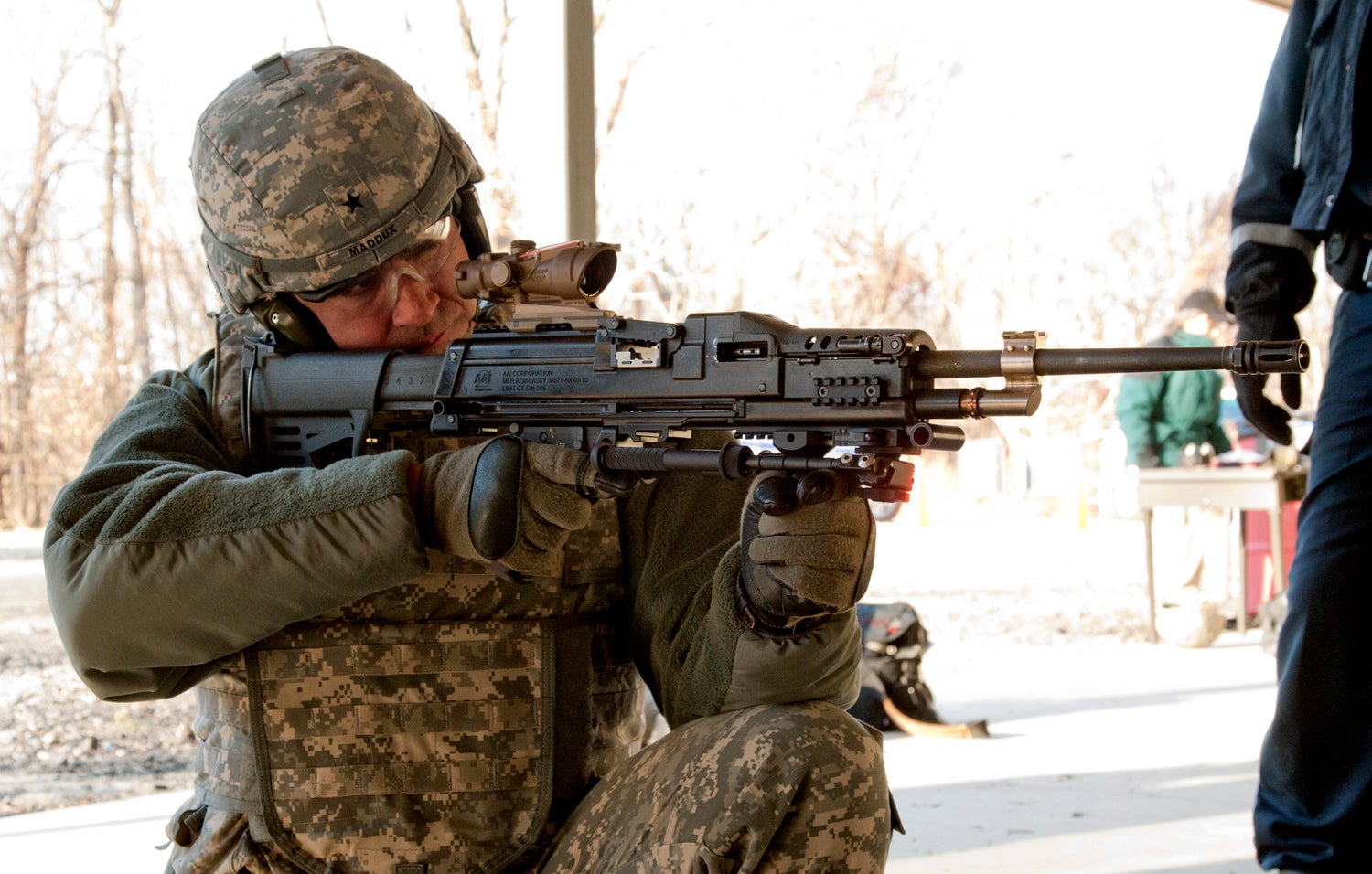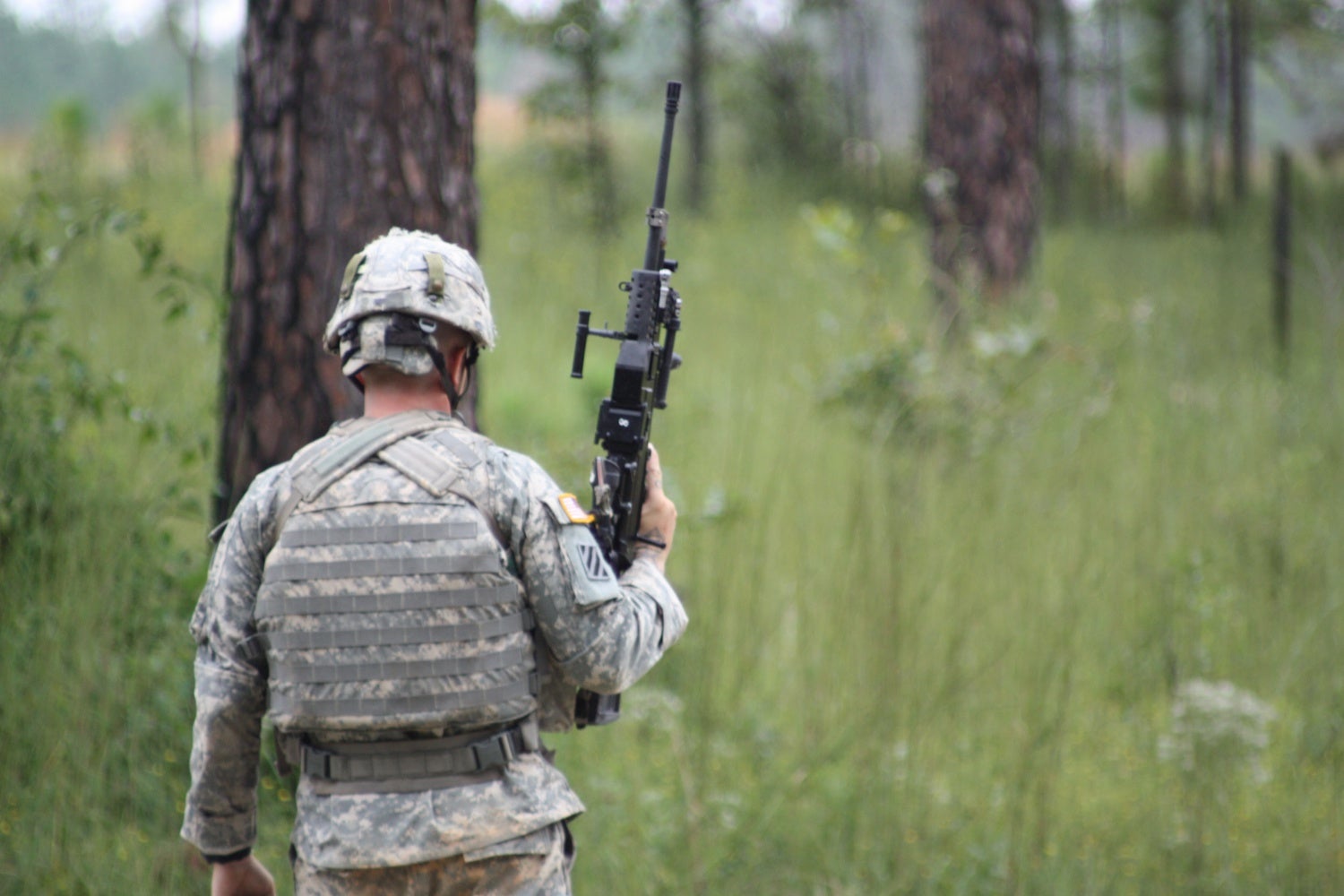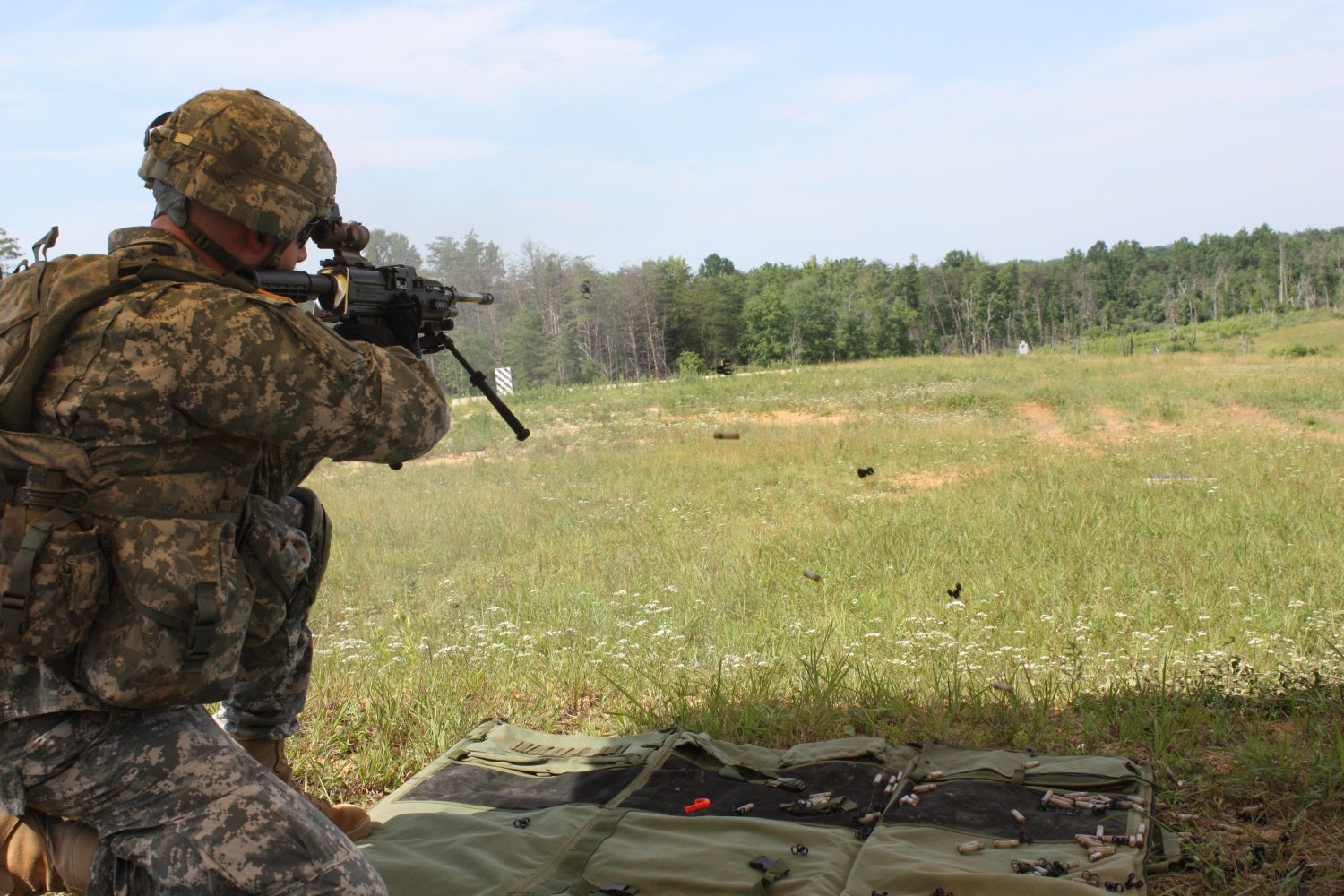INTERVIEW with Kori Phillips, Program Officer for LSAT and CTSAS, Part 1: Program History and Ammunition Technical Discussion
Not long after SHOT Show, I got the chance to interview Mrs. Kori Phillips, former program officer for the Army’s Lightweight Small Arms Technologies (LSAT) program, and current program officer for the Cased Telescoped Small Arms Systems (CTSAS) program. We talked at length about both programs, the technology they developed, and the state of lightweight ammunition today. The interview, which spans fifty-five questions, will be broken up into three sections, each covering questions about different aspects of the program, to be published monthly once each in March, April, and May. This first installment deals primarily with the history of the LSAT and subsequent CTSAS programs, with a little bit of the ammunition technology thrown in.
Before we begin, I would like to take a moment to thank Kori and Frank for taking the time to speak with me. They were very patient with me and did not hesitate to answer any of my questions.
Now, we’ve got a lot to get through! My questions are labeled with a bold “TFB“, while Kori’s answers are labeled with a bold “KP“:
TFB: LSAT began in 2004, correct? What were its origins and how did the project start?
KP: The first contracts were awarded in 2004, but there was preliminary research done in 2003 to establish state of the art for this type of technology.
TFB: You were involved in the program from the start, right?
KP: You got it. I started on LSAT in 2003, before it was LSAT.
TFB: Can you tell me more about the genesis of this program? Was this sort of a reaction to the abandonment of caseless ammo after the ACR program?
KP: It didn’t really have anything to do with ACR. The genesis was some combat load studies. They had never asked us before to strictly reduce the weight; it was always “can you reduce the weight and make it shoot further?” or “can you reduce the weight and make it more lethal?” Eventually we drew a line in the sand and said “look, we’re gonna reduce the weight and that’s it.” They were very happy with that, we called it “weight watchers for weapons”.

TFB: This is where you went to the lightweight 5.56mm machine gun?
KP: Yes, initially it was called the Lightweight Family of Weapons and Ammunition. That included a carbine, an LMG and a medium machine gun. At some point we ran headlong into the XM8 program, and because these two programs intersected they asked us to stop working on the carbine and just focus on the LMG. That was when we changed the name to Lightweight Small Arms Technologies, and it became strictly a 5.56mm belt fed light machine gun, but we hadn’t decided on the ammunition configuration at that point – caseless or cased telescoped.
TFB: So you were the program manager at that point?
KP: Actually I was working for a guy who was running the family of objective weapons, so that actually included OICW, OCSW, and this new system. He retired, and then I inherited this program; the other two were transitioned out. Technically, I am a project officer not a project manager, but we have the same duties, just for smaller scale programs.
TFB: By the time it became LSAT, had you decided on an ammunition configuration, caseless or cased telescoped?
KP: We hadn’t yet. The decision to change came after.
TFB: The caseless ammunition effort from LSAT was inherited essentially from Dynamit Nobel, right?
KP: Yes, although since the 1980s, their ammunition had since become impractical to produce in the 2000s, for cost and environmental reasons. Essentially, they were using a solvent based process where you mix all the ingredients together wet, and then let them dry out. That’s not something we prefer to do now because it produces a lot of toxic gases.
TFB: When doing research for this interview, I found some indication that there was a lot of “tribal knowledge” at Dynamit Nobel related to the caseless program that was subsequently lost when the program ended and people retired. Is that the case, and could you elaborate on that?
KP: I think Dynamit Nobel was actually purchased by another company which took their name. The people who actually worked on this technology had all retired or moved on. There was nobody to call, really. The thing is, they didn’t really have a complete recipe for the caseless ammunition. It looked like a complete recipe, until we went to go make it and then it wasn’t the same.
TFB: So you had to do a lot of work yourself to make a feasible caseless round?
KP: Yes, there was a combination of reverse-engineering the ammunition that we had, and also sort of analyzing the data that we had to figure out what was missing. But we were able to successfully recreate the exact chemical configuration that Dynamit Nobel delivered for ACR. It ended up costing too much to make!

TFB: So from your perspective you were able to catch up to where they were at for ACR, and it turned out to have some shortcomings?
KP: Right. We did what we call TRL 5. We tested it, it worked, and based on the manufacturing study that we had done, it was basically unaffordable in that configuration. This was about 2007 or so, I think. We did that test, and then what came out of it was a realization that if we wanted to continue with it we would have to change dramatically from the original configuration.
TFB: Is that about the time you decided to hand off caseless in favor of cased telescoped?
KP: Actually, we worked on it for a few years after that. The thing that drove us towards CT and away from caseless was that we had a request to do an operational assessment. So basically, we needed to get our act together, get a baseline, and get a bunch of ammunition made. That’s when we decided to focus our efforts, and then hand off the caseless to Office of Naval Research. And to be clear, when we started LSAT, we already had the ONR on board. The caseless program being managed by ONR addresses not only performance, but also manufacturability and cost.
TFB: OK, so they had already been your partners in that, and decided to take caseless under their wing while you prepared for the operational assessment with CT.
KP: Yep.
TFB: What did you start with when you had inherited the program? Was there a body of research to build on?
KP: Initially, we didn’t envision using caseless and cased telescoped. We talked to the industry, asked for their best ideas, and those two concepts came back to us a couple of different times in a couple of different ways. The initial suggestion was that these were the best ways to maximize the weight reduction for a whole variety of reasons. What we had done prior to that in 2003, was looking at making legacy ammunition out of polymer. Our conclusion was that the return on investment wasn’t really there, so we didn’t pursue it. With CT, we saw we were looking at an immediate 33% weight reduction without any compromises in how the ammunition worked. The difficulty then was that you needed a brand new weapon system. That’s what makes this such a hard sell, because it’s brand new ammunition and you can’t retrofit older weapons for it. We were trying something different that was very technically successful, but it’s always been a problem logistically because you have to commit to buy both systems at once, ammunition and weapon.

TFB: What is the relationship between CTSAS and its contractor Textron? Have the developments shown recently been direct requests from the CTSAS program to Textron? To what degree are they independent developments by Textron?
KP: Textron is under contract with the US Government to develop these technologies. The Government does not dictate the design specifics, Textron has years of experience and understanding of CT systems, and is fully qualified to develop the best system within the required parameters.
TFB: With regards to how the CTSAS program and Textron are related, are you literally unified teams, or are they your contractor?
KP: Let’s step back a bit. Back in 2004, we awarded two contracts, one was for General Dynamics, the other was for AAI. We downselected to AAI in around 2005, and in 2008 we awarded another contract to AAI. Textron subsequently bought AAI, and the team remained the same. Back in 2004, we were one team basically, the government half of the team and the contractor half of the team worked together seamlessly. We had a large Government team, including ammunition and weapons experts, as well as experts in propellants, ballistics, materials, systems engineering, and acquisition. We also had user representation from the Army and Marine Corps. On the contractor side, subcontractors to AAI included ARES Inc., ATK (Lake City, MO and Brigham City, UT locations), Veritay Technology, and GD-OTS St. Marks Powder. In the peak years, we had over 60 people participating in the program. Over the years, our funding has been cut back, and now I no longer have a government team. It’s just me. So essentially, it’s a contractor-driven effort with government oversight. It’s still the same people at Textron that were at AAI. As well as a government and industry person can understand each other, AAI/Textron and I have a great relationship. So I am pretty confident that even though I don’t have a government team supporting them, that their team has the tools they need to be successful.
TFB: So at this point in the story, you start having functioning weapons and actually are putting rounds downrange. How did that go, and how did they compare to the M249s? What problems did you have, and what improvements did you make?
KP: Every time you shoot it, you learn something. Sometimes it’s something minor, sometimes it’s something major. Here’s an anecdote: The four star general of TRADOC was shooting with us, and he gets behind the gun, and pulls the trigger once and the gun fires. He pulls the trigger again, and nothing happens. It turns out that the ammunition was actually coming apart, the endcap and the case were coming apart. We knew that, because there was propellant spilled all over the place. This was very early in the program, and what that was was that we needed a different way to attach the cap to the case. That was a good example of a problem that you wouldn’t discover in the lab, you had to actually shoot it.
Another problem we had was that because the ammunition parts are molded, that can provide you with a very high level of repeatability, but it can also be bad if your mold isn’t set up correctly. What happened is our mold got off-center some time along the way, and the primer hole and where we were inserting our primer were not co-located. There was a gas gap there that led to some pretty ugly misfires.
TFB: That brings up an interesting point, you know you’re not just making a new caliber of ammunition or a new bullet, you have a completely new kind of manufacturing and loading that you have to troubleshoot. Which makes me think, did you ever have a problem with solvents or other chemicals getting on the polymer and damaging the ammunition?
KP: Actually, part of the technical testing we did for TRL 6 or 7 is a whole series of environmental testing, hot, cold, sand, dust, ice. One of those tests is chemical compatibility. We were nervous, I gotta tell you. There’s this whole list of like 20 different chemicals that you have to expose them to, one of them is DEET, bug repellent, which is incredibly corrosive. Another one is tropical bleach, which is nasty stuff. So we went through all the chemical compatibility testing, and we actually passed it all. We didn’t have any problems. This polymer that we selected is a very resilient polymer, it’s a medical-grade polymer, so it can be sanitized, it can be bleached, and it still continues to function. It’s a really good material.

TFB: Now does that polymer still give you most of the cost advantage vs. brass that you would get with another polymer?
KP: Well, it’s one of the most expensive polymers you can get your hands on, but the cost is worth it because we need it. The cost per pound is a lot more than brass, but remember you’re using a lot less polymer by weight for each case than you would be with brass. From a strict material cost perspective, it probably costs a little more than brass at this point.
TFB: Do you think that cost will come down if we get to the point where you are producing a billion rounds of it per year?
KP: Yes. If it’s gonna be used for small-caliber ammunition, I think it’s a different ball game altogether. There will be a huge cost savings because of the economy of scale. Plus, you’re doing injection molding instead of drawing a brass case in 12 steps or however many, so there will be a substantial cost saving from that.
TFB: One of the big draws for me for LSAT/CTSAS is that the ammunition promises to be a lot less expensive.
KP: Yeah, I’ve tried and it’s actually hard to make that argument because at this stage, I just can’t prove it. We aren’t buying the material in quantity yet, we don’t have a production level manufacturing facility. But yes, my feeling is that it will cost less once you get to true production status. There’s a lot of disbelief, people think “it can’t possibly cost less than a brass-cased round”, and there’s some truth to that. Brass ammunition is very cheap in terms of manufacturing cost, like fifteen cents to make a round. It’s hard to compete with that. But I think CT will be cheaper.
The second installment of this interview will be published in April. Stay tuned!
